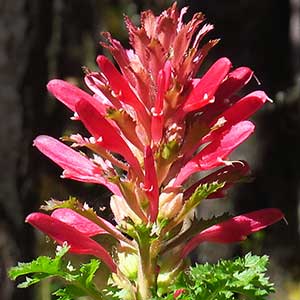Pedicularis densiflora
Pedicularis hirsuta
Indian warrior, warrior's plume
hairy lousewort, pédiculaire hirsute
basal 1–10, blade lanceolate, 30–200 x 20–70 mm, 2(or 3)-pinnatifid, margins of adjacent lobes nonoverlapping or extensively overlapping distally, 1-serrate, surfaces glabrous, hispid, or downy;
cauline 4–20, blade lanceolate, 15–250 x 5–100 mm, 2-pinnatifid, margins of adjacent lobes nonoverlapping or extensively overlapping distally, serrate, surfaces glabrous, hispid, or downy.
basal 3–10, blade elliptic to lanceolate, 5–20 x 2–5 mm, 1(or 2)-pinnatifid, margins of adjacent lobes nonoverlapping or slightly overlapping distally, serrate, surfaces glabrous;
cauline 3–10, blade lanceolate to oblanceolate, 5–30 x 1–7 mm, 1-pinnatifid, margins of adjacent lobes nonoverlapping or slightly overlapping distally, serrate, surfaces glabrous.
simple, 1–5, exceeding basal leaves, each 10–50-flowered;
bracts lanceolate to trullate, 10–35 x 3–5 mm, undivided or 1-pinnatifid, proximal margins entire, distal 1- or 2-serrate, surfaces glabrous.
simple, 1–10, exceeding basal leaves, each 5–25-flowered;
bracts lanceolate, 5–15 x 1–5 mm, 1-pinnatifid 1/2–3/4 to midrib, proximal margins entire, distal serrate, surfaces densely wooly.
2–4 mm.
2–5 mm.
calyx 9–18 mm, downy to tomentose, lobes 5, triangular, 3–4 mm, apex entire, ciliate;
corolla 23–43 mm, tube dark red, purple, or orange-yellow, rarely white, 8–18 mm;
galea dark red, purple, or orange-yellow, rarely white, 15–25 mm, beakless, margins entire medially and distally, apex straight;
abaxial lip dark red, purple, or orange-yellow, rarely white, 8–15 mm.
calyx 7–10 mm, densely woolly, lobes 5, triangular, 1–4 mm, apex entire or serrate, glabrous or ciliate;
corolla 11–19 mm, tube pale pink, sometimes white, 6–14 mm;
galea pale pink, sometimes white, 4–7 mm, beakless, margins entire medially, 1-toothed distally, apex nearly straight to arching slightly over abaxial lip;
abaxial lip pale pink, sometimes white, 4–5 mm.
= 16.
= 16.
Pedicularis densiflora
Pedicularis hirsuta
Scarlet corollas with an undomed, toothless galea and two- or three-pinnatifid leaves are diagnostic of Pedicularis densiflora. This species occurs in forested subalpine regions of southern Oregon, western slopes of the Sierra Nevada, and the Coast Ranges of California south to Baja California. Herbarium records indicate northern populations of P. densiflora occur at higher elevations than do more southern populations.
(Discussion copyrighted by Flora of North America; reprinted with permission.)
Pedicularis hirsuta can be difficult to distinguish from P. lanata. Unlike P. lanata, the galea subapex of P. hirsuta is toothed. Floral surfaces of P. lanata are sparsely to densely hirsute; those of P. hirsuta are glabrous. On fresh specimens, the roots of P. hirsuta are pale yellow; those of P. lanata are bright yellow.
(Discussion copyrighted by Flora of North America; reprinted with permission.)


